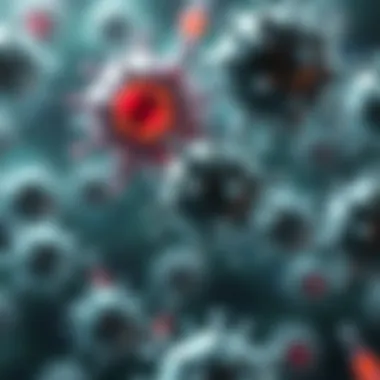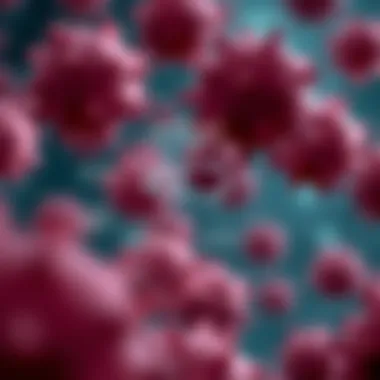Antibiotics and STDs: Understanding Their Relationship


Intro
The intersection of antibiotics and sexually transmitted diseases (STDs) forms a landscape riddled with misconceptions and complexities. Many people hold a belief that antibiotics are a catch-all solution for STDs, but this notion lacks grounding in the biological realities of infection treatment. To genuinely comprehend the nuances of this topic, one must navigate the specificities of each infection and the remedies available. It's not merely about popping a pill; it's about understanding which antibiotics are effective against which STDs and recognizing the limitations that come into play.
As sexually active individuals, the responsibility of safeguarding sexual health can often feel overwhelming. With the rise of antibiotic resistance, the landscape of treatment options is shifting, and the implications are profound. This article aims to clarify these relationships for students, educators, and health professionals, offering not just insights but also practical guidance. By exploring key findings in this domain, we uncover essential truths that lie beneath the surface of common assumptions.
Health literacy in this sphere is critical, and knowing when to seek medical guidance can make all the difference in effectively managing STDs. This narrative seeks to unpack this urgency, enrich understanding, and frame a more informed dialogue around a topic that impacts millions worldwide.
Understanding Sexually Transmitted Diseases
Sexually transmitted diseases (STDs) are a major public health concern, affecting millions of people worldwide. Understanding STDs is crucial in today's context as they significantly impact not just individual health, but entire communities as well. This section aims to unpack what STDs are, their types, and their prevalence and impact, all of which are foundational to grasping the role of antibiotics in their treatment.
Definition and Types of STDs
STDs are infections that are commonly spread through sexual contact. They can be caused by bacteria, viruses, or parasites. While some common examples include chlamydia, gonorrhea, syphilis, HIV, and herpes, the classifications can be simplified into several categories:
- Bacterial STDs: These include infections like chlamydia and gonorrhea, which can often be treated effectively with antibiotics.
- Viral STDs: This category encompasses diseases including HIV and herpes. Current treatments may manage symptoms but do not completely eradicate these infections.
- Parasitic STDs: Trichomoniasis falls under this category and is treatable but is often overlooked.
Recognizing and categorizing these STDs is essential because it directly influences the treatment options available. Antibiotics are notably effective against bacterial forms, de-emphasizing the necessity for clear distinctions among these types.
Prevalence and Impact of STDs
The prevalence of STDs is staggering. For instance, the World Health Organization estimates that more than one million STDs are acquired every day globally. Moreover, the impact of STDs extends beyond physical health, affecting emotional well-being, relationships, and even economic stability. Understanding these dynamics is paramount, as people may not recognize their risk or the importance of early diagnosis and treatment.
Here are key impacts to consider:
- Health Consequences: Untreated STDs can lead to severe complications, including infertility, chronic pain, and increased risk of HIV.
- Social Stigma: Individuals may experience shame or embarrassment, causing delays in seeking treatment. This can lead to further spread of infections.
- Economic Costs: The health care costs associated with untreated STDs can be substantial, affecting personal finances and health systems.
The Role of Antibiotics in Medicine
Antibiotics have become a cornerstone in modern medicine, bridging treatment gaps in various bacterial infections. Their pivotal role extends beyond just tackling straightforward illnesses; they fundamentally alter the landscape of medical care. As we explore how antibiotics function, it is critical for readers — ranging from students to healthcare professionals — to grasp their significance in treating sexually transmitted diseases (STDs) alongside other bacterial infections.
In the context of STDs, antibiotics serve not merely as therapeutic agents but as crucial allies in public health efforts aimed at containment and prevention. For example, the successful treatment of infections like gonorrhea and chlamydia can disrupt the cycle of transmission, leading to fewer new cases. The implications of effective antibiotic use in this domain cannot be overstated, as they play a vital role in reducing morbidity and associated complications, particularly in reproductive health.
However, it's not just about what antibiotics do; it’s also essential to consider how they do it effectively. The balance between efficacy and safety is critical. Moreover, understanding their limitations sheds light on the risks of using antibiotics when unnecessary, which can contribute to the broader public health challenge of antibiotic resistance.
Mechanism of Action
Antibiotics act primarily by targeting specific functions within bacteria, and understanding their mechanisms offers valuable insight into their potential and limitations.
- Cell Wall Synthesis Inhibition: Certain antibiotics like penicillins impede the formation of bacterial cell walls, leading to cell lysis. This method is particularly effective against bacteria that rely on their cell walls for structural integrity.
- Protein Synthesis Interruption: Another category includes antibiotics such as tetracyclines, which inhibit bacterial protein production by targeting ribosomes. This halt in protein synthesis leads to bacterial stasis or death, depending on the concentration.
- Nucleic Acid Inhibition: Antibiotics like fluoroquinolones disrupt DNA replication and transcription, blocking the bacteria's ability to proliferate.
The diversity in mechanisms means that specific antibiotics are best suited to particular bacterial pathogens, so precise diagnosis is paramount. Misuse of antibiotics against viral infections or those resistant to treatment can lead to significant consequences, emphasizing the need for medical guidance in STD management.


Types of Antibiotics
Antibiotics can be broadly categorized based on their spectrum of activity and mechanism of action. Knowing these types is essential for appropriate treatment selection.
- Broad-Spectrum Antibiotics: These affect a wide range of bacteria, which is particularly useful in empirical therapy when the exact pathogen isn't identified. Examples include amoxicillin and tetracycline.
- Narrow-Spectrum Antibiotics: Target specific types of bacteria, minimizing disruption to normal flora. This group includes penicillin G and azithromycin, often used in treating specific STDs like syphilis and chlamydia.
- Bactericidal Antibiotics: These kill bacteria directly, making them effective for severe infections. Examples include glycopeptides like vancomycin.
- Bacteriostatic Antibiotics: Instead of killing, they halt bacterial growth, giving the immune system a chance to eliminate the infection. Tetracyclines often fall into this category.
"The choice of antibiotic is intricately connected to the bacterial organism involved and the potential for resistance development, which has profound implications for STD management."
Antibiotics and STDs
Antibiotics have long been touted as a miracle of modern medicine, especially in the treatment of bacterial infections. However, when it comes to sexually transmitted diseases, the relationship is intricate and sometimes misleading. Understanding how antibiotics interact with STDs is crucial for anyone looking to navigate their sexual health effectively.
With the rise of antibiotic resistance and misconceptions surrounding treatment options, it’s essential to grasp the nuances involved. The effectiveness of antibiotics varies vastly between different STDs, leading to essential considerations in diagnosis and treatment plans. The relevance of this topic becomes clear when one considers the implications of improper treatment and the resultant public health crisis.
Curable STDs
Certain STDs can be effectively treated with antibiotics, providing a clear pathway for recovery. These include chlamydia, gonorrhea, and syphilis. In these cases, the timely application of antibiotics can completely eradicate the bacteria responsible for the infection, restoring health and well-being.
- Chlamydia is often asymptomatic, which is why regular testing is vital. Once diagnosed, a simple course of azithromycin or doxycycline can clear the infection swiftly.
- Gonorrhea is becoming increasingly resistant to treatment, but antibiotics like ceftriaxone remain effective when administered correctly and timely.
- Syphilis, while it may sound daunting, is treatable with penicillin, and early intervention can lead to complete recovery without significant complications.
With these treatable STDs, awareness and proactive screening play paramount roles. Regular check-ups can ensure that infections are caught early, making treatment more straightforward and effective.
Antibiotic Resistance: A Growing Concern
The topic of antibiotic resistance is not just a passing trend; it’s a significant health crisis that poses serious challenges in effectively treating sexually transmitted infections (STIs). As antibiotics lauded for their potency fall short against burgeoning resistant strains, the implications extend far beyond a mere inconvenience for healthcare providers. At the core, antibiotic resistance undermines decades of medical advancements by transforming once-treatable infections into looming threats. Understanding this phenomenon in the context of STDs is paramount to change the tide in sexual health management.
The importance of this discussion is multifaceted. For starters, as gonorrhea and other STIs develop resistance, they not only threaten individual health but herald broader public health implications. Eradicating a common infection could require far stronger, possibly toxic alternatives, leading to increased healthcare costs and strained healthcare resources. Moreover, cultural stigmas associated with STDs often mean that individuals may delay seeking treatment, allowing resistant infections to flourish unopposed.
Key Considerations of Antibiotic Resistance:
- Increased Difficulty in Treatment: If a pathogen becomes resistant, the treatment options become limited.
- Consequences on Public Health: Resistant STIs can lead to outbreaks and longer duration of illness, making it harder to control transmissions.
- Impact on Healthcare Costs: Treating resistant infections often requires more expensive and intensive care.
In short, before one even considers treatment options, understanding antibiotic resistance is an essential step in developing effective strategies for controlling STDs.
Mechanisms of Resistance
Antimicrobial resistance occurs through various mechanisms that allow pathogens to survive despite antibiotic exposure.
- Genetic Mutation: Bacteria can naturally mutate, leading to traits that might protect them from antibiotics. This can happen spontaneously during reproduction, creating a new lineage that doesn’t succum to standard treatments.
- Horizontal Gene Transfer: Bacteria can share genetic material, allowing resistant traits to spread among different species—a concerning capability that accelerates the issue of resistance.
- Efflux Pumps: Some bacteria possess structures that actively pump antibiotics out of their cells, thereby preventing the drugs from reaching effective concentrations inside.
These methods act like a sturdy fortress, guarding the bacteria against the assaults of antibiotics that once had their measure. As a consequence, it becomes increasingly vital for healthcare professionals to judiciously prescribe antibiotics and for patients to understand the importance of adhering to treatment guidelines without prolonging or prematurely ending their course.
Impact on STD Treatment


The implications of antibiotic resistance on STD treatment can't be overstated. As bacteria adapt, the treatment landscape shifts dramatically, creating a breeding ground for ineffective therapies.
- Changes in Treatment Guidelines: Antibiotic resistance often necessitates that medical professionals revisit and revise existing treatment protocols for common STIs like chlamydia and gonorrhea, introducing both uncertainty and complexity into patient care.
- Increased Risk of Complications: Infections that are resistant to first-line treatments can lead to more severe health issues, including pelvic inflammatory disease in women, which might subsequently impair fertility.
- Public Health Risks: The more prevalent resistant strains become, the greater the risk for uncontainable outbreaks, raising the stakes for overall community health.
- Mental Health Strain: The continuous struggle with resistant infections can lead to anxiety and stress for patients, who may fear the implications of persistent symptoms or complications.
"Addressing antibiotic resistance is not just a medical imperative; it’s a necessity for our shared social and economic well-being."
As the battle against antibiotic-resistant STDs wages on, educating both patients and healthcare professionals is critical for overcoming this hurdle. Understanding the intricacies of resistance can help drive practices that not only combat current strains but also pave the way for improved sexual health in the future.
Importance of Medical Guidance
When it comes to tackling the complications surrounding sexually transmitted diseases (STDs) and the role of antibiotics in their treatment, seeking medical guidance is not just advisable; it's essential. The intricate web of STDs and antibiotic use creates a landscape where misinformation is rampant. Without the proper direction from healthcare professionals, individuals risk overlooking critical details that could significantly alter their treatment outcomes.
Consulting Healthcare Professionals
Navigating the murky waters of STDs requires an informed approach. Consulting healthcare professionals is paramount. Doctors and specialists have the training and expertise to provide tailored advice based on an individual's health history and current condition. Here are some elements underscoring why professional guidance is invaluable:
- Diagnosis Accuracy: A licensed healthcare provider can accurately diagnose the specific STD involved. This often involves various tests, which can pinpoint not just the presence of an infection but also its type.
- Tailored Treatment Plans: Not all STDs are created equal, and the effectiveness of antibiotics can vary. A professional can prescribe the most effective antibiotic based on the identified pathogen.
- Monitoring and Follow-up: Ongoing medical oversight ensures that the treatment is working as intended. If resistance develops or if the symptoms do not improve, adjustments can be made promptly.
In addition to these aspects, healthcare consultations offer a platform for addressing any misconceptions or fears surrounding STDs, fostering a more informed patient.
Understanding Treatment Options
Awareness of the available treatment options is fundamental to managing STDs effectively. However, understanding the broader realm of treatments can be overwhelming. Here’s a rundown of critical considerations when evaluating treatment alternatives:
- Types of Medications: Antibiotics are typically the frontline defense against certain bacterial STDs, such as chlamydia and gonorrhea. However, there's a contrasting landscape when it comes to viral infections like HIV or herpes, which do not respond to antibiotics.
- Educated Choices: Knowing the range of treatment options—including antibiotics, antiviral medications, and adjunct therapies—enables patients to engage in meaningful discussions with their healthcare providers. This dialogue can help navigate choices based on personal circumstances.
- Side Effects and Interactions: Many antibiotics come with potential side effects. Being aware of these can help mitigate risks. Furthermore, some patients may be on medications that can interact negatively with antibiotics. Understanding these intersections is crucial.
"Effective management of STDs hinges not only on immediate treatment but also on a long-term understanding of one’s health."
The importance of this guidance cannot be overstated, as it ultimately arms individuals with the knowledge to advocate for their own health. With accurate information and professional support, patients stand a better chance of navigating the complexities associated with STDs and antibiotics, leading to improved health outcomes.
Prevention Strategies for STDs
Prevention is the cornerstone of managing sexually transmitted diseases (STDs). Having a proactive approach safeguards not just individual health, but also contributes to public health on a broader scale. Understanding the specific strategies for prevention empowers people to make informed decisions regarding their sexual health. It's not solely about the medical side; an awareness of one's choices plays a significant role in preventing the spread of these infections.
Safe Sex Practices
The phrase "safe sex" is often thrown around, but what does it really entail? At its core, safe sex includes a range of behaviors that aim to minimize the risk of STDs.
- Condom Usage: Utilizing latex or polyurethane condoms significantly reduces the likelihood of transmitting STDs. They act as a barrier, shielding against many infections including HIV, chlamydia, and gonorrhea.
- Regular Testing: Routine STD screenings are crucial, especially for sexually active individuals with new or multiple partners. Early detection can halt the spread and ensure timely treatment.
- Mutual Monogamy: Entering a mutual monogamous relationship where both partners are tested can decrease risk. However, it’s important that both parties understand their sexual health status.
- Communication: Open discussions about sexual history and health with partners can help set expectations and foster a sense of responsibility. It's not easy, but it’s vital.
"Prevention is better than a cure. The more informed you are, the better choices you can make."
Avoiding substances that impair judgment during sexual encounters can also live up to safe sex practices. Alcohol and drugs might lead to risky behaviors, undermining the very goals of prevention strategies.


Vaccinations
Vaccinations serve as an additional proactive measure against certain STDs. Much like how vaccines have historically curbed diseases, they provide crucial protections in the realm of sexual health.
- Human Papillomavirus (HPV) Vaccine: This vaccine is highly recommended, particularly for young people before they become sexually active. HPV is linked to several cancers, and the vaccine can help prevent its most harmful consequences.
- Hepatitis B Vaccine: Hepatitis B is a serious virus that affects the liver, and fortunately, it can be prevented through vaccination. It’s particularly recommended for anyone at risk of contact with infected bodily fluids.
- Meningitis Vaccines: While less directly connected to STDs, the meningococcal vaccine can protect against certain types of bacterial infections transmitted in various ways.
The integration of vaccinations into a broader prevention strategy emphasizes the importance of preemptive measures. Moreover, staying up-to-date with medical guidance ensures that individuals are shielded against illnesses that could profoundly impact their lives.
By adopting safe sex practices and considering vaccinations, individuals can take substantial steps towards safeguarding their sexual health. These strategies not only enhance personal well-being but also contribute to a healthier, more informed community.
Future Directions in STD Research
Research into sexually transmitted diseases (STDs) is at a pivotal juncture, reflecting the evolving landscape of both medical science and public health. The need for comprehensive strategies that encompass treatment and prevention of STDs has never been more crucial. Future directions hinge on the intersection of innovation, improved understanding of microbial behavior, and a committed approach to tackling issues like antibiotic resistance. This section aims to illuminate the promising pathways in STD research, highlighting innovation in treatments and strategies to combat antibiotic resistance.
Innovative Treatments
In the quest for better outcomes in STD management, researchers are delving into a variety of innovative treatments. One promising avenue is the development of targeted drug therapies. Unlike traditional antibiotics that may target a broad spectrum of bacteria, these therapies hone in on specific pathogens. This makes them less likely to disturb the body's normal flora, potentially reducing side effects and the risk of secondary infections.
Additionally, immunotherapy is emerging as a game changer for chronic STDs, particularly those that are viral in nature, like HIV and HPV. This approach works by boosting the body's own immune response to infections. Some novel vaccines are also in the pipeline, aiming to prevent STDs before they even manifest.
Furthermore, researchers are exploring the role of microbiome modulation. The idea here is to change the composition of the vaginal or penile microbiome to create an environment less hospitable to pathogens. Not only does this tackle the problem from a preventive angle, but it also opens up avenues for maintaining sexual health through dietary or probiotic interventions.
These innovative treatments exemplify a forward-thinking approach, aiming to reduce the long-term burden of STDs and improve patient outcomes.
Addressing Antibiotic Resistance
Antibiotic resistance poses a grave challenge to public health globally, and it is especially concerning in the realm of STDs. The misuse and overuse of antibiotics have accelerated the emerging patterns of resistance, making once-treatable infections increasingly difficult to manage. Future research aims to illuminate the mechanisms behind this resistance to devise more effective strategies for combating it.
One of the focal points will be understanding bacterial mutation. By unraveling how bacteria evolve to withstand antibiotic treatment, researchers can engineer drugs that circumvent these resistance mechanisms. For example, studies are investigating the genetic alterations that confer resistance to neisseria gonorrhoeae, the bacterium responsible for gonorrhea, opening up paths for novel therapeutic discoveries.
Moreover, surveillance systems are essential to monitor resistance patterns. By establishing a robust global network for tracking resistance trends, researchers can adapt treatment protocols dynamically, ensuring they remain effective in the face of evolving bacteria.
Public awareness campaigns will also be pivotal. Educating individuals on the responsible use of antibiotics—like not self-prescribing or not completing courses—can significantly curb resistance development.
In summary, tackling antibiotic resistance will not only enhance STD treatment but also contribute to a broader shift towards sustainable health practices. The future of STD research is indeed encouraging, brimming with potential but also demanding rigorous efforts and collaboration across disciplines.
End: Understanding the Limitations of Antibiotics
In the context of treating sexually transmitted diseases (STDs), recognizing the limitations of antibiotics is crucial. While these medications have revolutionized medical treatment and have proven effective against certain infections, it is essential to approach their use with a critical eye. Over-reliance on antibiotics without comprehensive understanding can lead to misguided treatment approaches and increasing resistance, ultimately undermining their effectiveness.
When discussing the limitations of antibiotics, several key areas deserve emphasis:
- Scope of Effectiveness: Not all STDs can be treated with antibiotics. Conditions like HIV and herpes are viral and, therefore, require different therapeutic strategies. Misconceptions surrounding the universality of antibiotic treatment could lead individuals to delay appropriate care for these serious conditions.
- Development of Resistance: The prevalence of antibiotic resistance poses a significant challenge. As bacteria evolve, they may develop mechanisms to evade the effects of these drugs. This is particularly concerning in the realm of STDs, where resistant strains can complicate standard treatment protocols, resulting in prolonged infections and more severe health outcomes.
- Consequences of Misuse: Unnecessary use of antibiotics can contribute to worsening this resistance problem. For instance, if someone with a viral STD receives antibiotics, not only does it fail to treat the underlying condition, but it may also promote the growth of resistant bacteria in their system.
"Antibiotics are a powerful tool, but like any tool, they must be used wisely. Misapplication can result in consequences far beyond the original problem."
- Importance of Professional Guidance: Instead of relying solely on self-diagnosis or over-the-counter solutions, it is vital for individuals to seek medical advice to ensure they receive the correct diagnosis and treatment. Professionals can recommend the appropriate tests, interpret results accurately, and advise on effective treatment options that antibiotics alone may not cover.
By understanding these limitations, patients can become more informed participants in their own health care. They should feel empowered to ask questions and clarify any uncertainties regarding their treatment plans.
Ultimately, the aim is clear: to foster a well-rounded understanding of sexual health, the role of antibiotics, and the necessity of proper guidance and stewardship in managing STDs. Recognizing that antibiotics are not a cure-all will lead to more effective treatment strategies and healthier outcomes.



